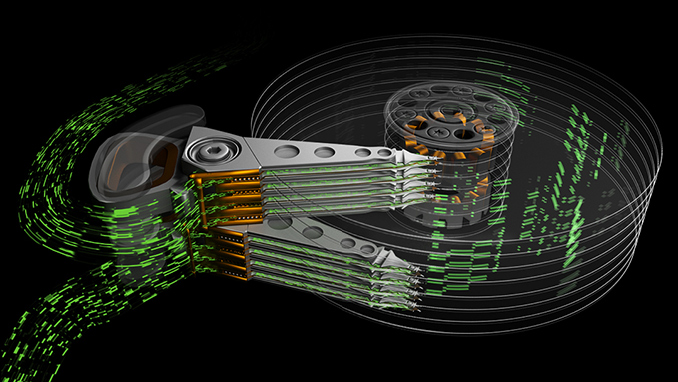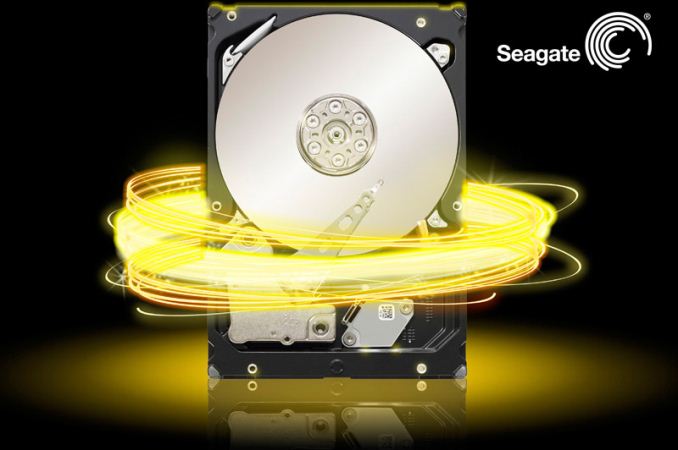Seagate’s Multi Actuator Technology to Address HDD IOPS Woes
by Anton Shilov on December 29, 2017 12:01 PM EST
Seagate introduced its new Multi-Actuator Technology (MAT) for hard drives earlier this month. It promises to increase hard drive performance by using two or more sets of actuator arms that operate independently from a single pivot point. Seagate claims that next-gen HDDs will require higher performance to effectively take advantage of their increased capacities. It plans to use MAT in their datacenter hard drives going into pilot production in 2018.
To improve the performance of next-generation hard drives, Seagate proposes to install not one, but two (or more) sets of actuators into a single HDD. The actuators are to be equipped with their own arms/heads as well as magnets to position them, but will use one pivot. As a result, the actuators will be able to act completely independently, essentially creating parallelism within a single hard drive. With an architecture like this, IOPS performance will scale with the number of actuators. Aggregate read/write performance of hard drives will also increase, but since it will depend on many factors, it is too early to make predictions regarding throughput of next-gen HDDs. The additional components required for two independent actuator assemblies (and a considerably more sophisticated HDD controller) will make such hard drives more expensive to build when compared to today’s models. This could be one of the reasons why Seagate plans to use its Multi-Actuator Technology only for hard drives designed for datacentres, where hardware costs are not as crucial as performance and features.
The first-generation MAT-enabled HDDs are to use two actuators operating on a single pivot point (along with 8 platters and 16 heads), but going forward the number of actuators may grow. Seagate says that the host computer can “treat a single Dual Actuator drive as if it were two separate drives”, but stresses that logically the HDD will remain a single device with two access streams for communication, just like dual-port SAS drives do. Meanwhile, Dual Actuator HDDs will be able to use not only SAS, but also NVMe and SATA interfaces. In the best-case scenario, a hard drive with two actuators can double the random read/write performance and almost double the sequential read/write performance compared to today's hard drives. The sequential access case is a bit tricky, since the cylinder height gets halved with two actuators, and a lot depends on how the addresses are translated to the actual physical sectors.
The arrival of new magnetic recording technologies in the coming years will significantly increase capacities of hard drives for cloud/exascale datacenters to over 20 TB by 2020 and to 40 TB within the next five or seven years. The upcoming HDDs will increase their sequential read/write performance along with the increase of their areal densities, but when it comes to latencies and random read and write operations, things get more complicated. The current HDD architecture uses a single actuator that synchronously moves all the arms with read-write heads over the media together for reading and writing data. With such an architecture, the platters can only work on one request at a time. Meanwhile, the more data an HDD stores, the more requests it gets and the more time it spends seeking the right track/sector. If/when fulfilling a request takes too long, quality of service (a metric dear to datacenter operators) suffers. Today, the performance bottleneck is solved by using either NAND flash or multiple hard drives in parallel, effectively combining their performance for certain access traces. At some point, this approach may become inefficient due to power/complexity and other factors. Therefore, it is imperative that HDDs get faster in order to cope with tomorrow’s workloads.
Seagate says that the Multi-Actuator Technology is to be deployed on products in the near future, but does not disclose when exactly. As the company’s blog post on the matter mentions both MAT and HAMR, it is highly likely that commercial hard drives featuring HAMR due in late 2019 will also have two actuators on a single pivot. At the same time, it does not mean that the MAT is not going to find itself a place in products using conventional PMR.
Related Reading
- Western Digital Stuns Storage Industry with MAMR Breakthrough for Next-Gen HDDs
- Toshiba Announces 14 TB PMR MG07ACA HDD: 9 Platters, Helium-Filled, 260 MB/s
- Toshiba Commercializes SDK’s 9th Gen PMR, Tech Enables 14 TB PMR HDDs in 2018
- Western Digital Now Shipping 14 TB HDDs: HGST Ultrastar Hs14 with 1000 Gb/in2
- Western Digital Announces Ultrastar He12 12 TB and 14 TB HDDs
- Seagate Announces Enterprise Capacity 12 TB HDD: 2nd-Gen Helium-Filled Hard Drives
Source: Seagate











88 Comments
View All Comments
Zok - Saturday, December 30, 2017 - link
While not a new idea, as this was done by Conner back in the 90s with their Chinook drive, the ratio of capacity to IOPS has become so skewed (disk rebuild time in RAID, for example) that dual actuators may finally show their worth. BTW, Connor was acquired by none other than Seagate in 1996: https://en.wikipedia.org/wiki/Conner_Peripheralsddriver - Saturday, December 30, 2017 - link
Not a few months ago I wrong about multiple actuators being one of the many possible directions to improve HDD performance.Of course, being mediocre, the industry is taking baby steps, barely incremental, as it is only two independent actuators.
Meh...
They are yet to take the courage to go for completely independent heads and multiple heads per platter.
Meanwhile my concepts went further, and now I've come up with a head that doesn't move, and can read and write at multiple locations on the same platter.
Rough simulations put a 4000 RPM drive with 4 such heads per platter at enough sequential throughput to fully saturate a PCIE 4 x8 link. Random performance is on par with the best SATA SSDs currently have to offer. Latency estimates average out at about 0.2 msec, not having to move actuators really helps out there. Additional extra features include flexible user configurable LBA layout with options to maximize performance or redundancy. Power usage estimates for a 100 TB model is around 80 watts, which might sound a lot compared to a regular HDD, but is actually very good considering the performance. And yes, it is 5.25 inch, it doesn't require noble gasses, fancy writing assistance like hamr and similar, it achieves that performance through massive low level parallelism, and since it doesn't push the limits of what outdated tech is capable of, reliability should be much better than contemporary high end HDDs.
mode_13h - Saturday, December 30, 2017 - link
Wow, if only these babies had talked to you...I'll bet the whole tech world could advance at like 10x if you'd just come out of your troll cave into the light of day and drop some of your golden knowledge nuggets on all these unenlightened industries. They'd probably add you to Mt. Rushmore and make your birthday a holiday on par with Presidents' and MLK day.
ddriver - Sunday, December 31, 2017 - link
That is a very safe bet. A lot is possible if you put progress and the benefit of the consumer first.Alas, the industry is all about milking the maximum amount of profit with the minimum possible amount of effort at the expense of the consumer.
mode_13h - Sunday, December 31, 2017 - link
Seriously dude, if you're so smart, why aren't you out there fighting bad guys, like Tony Stark? I'm sure you totally have an Iron Man suit design sitting around somewhere. Just get off your butt and build the darn thing!cjl - Saturday, December 30, 2017 - link
Even if your heads are spaced evenly around the platter, and can read any track instantaneously, your latency is still going to average out at just under 2ms, with worst case approaching 4ms. This is because there's no guarantee the data you want is at the rotational position where the head is located. In addition, you'd need hundreds of thousands of read/write heads on each "head", since there are around 400-450k tracks on a modern hard drive. This is absurdly, ludicrously cost prohibitive. I suspect you know almost nothing about the design or tradeoffs involved in modern hard drives, and thus you think your ridiculous concept is viable, but it's actually completely impossible to implement.mode_13h - Sunday, December 31, 2017 - link
Yeah, the hubris is strong with this one. Either that or it's an elaborate troll.Literally tens or hundreds of millions of hours have been poured into HDDs technology by physicists and engineers intimately familiar with all the myriad issues, many of which you only learn about through experience. In the ~50 years or so that HDDs have been with us, I'm pretty sure multiple people have explored pretty much every imaginable idea that even kind of makes sense.
cjl - Sunday, December 31, 2017 - link
To be entirely fair, sometimes good ideas do sit idle in an office somewhere for a long time even though they would be beneficial. For example, there were some working helium prototypes a very long time before anyone actually sold a commercial helium drive. However, that's usually a case where it's not unambiguously an advancement - helium significantly increases manufacturing complexity and unit cost, but gives substantially lower power and better track following capability. However, at the time the first prototypes were developed, the turbulence on the head stack wasn't really the limiting factor on density anyways, and the market cared more about drive cost than power consumption, so not much effort was put into it. Similarly, multi-actuator concepts have existed for a while (at least on paper), but it's so much additional cost that it wasn't really worth it until we started getting these 8 disk monstrosities that would take forever for a raid rebuild, and that have significantly worse random IOPS per TB the larger they get.Yes, the industry is focused on profit, and occasionally, good ideas slip by because of it. However, if any drive manufacturer could, for almost any price, make a 100TB, 0.2ms latency, hundreds of thousands of IOPS, multi-gigabit-per-second drive, they'd jump all over that in a heartbeat. They'd have instant dominance of the entire storage industry, and put pretty much all HDD and flash companies out of business right there. It would be a CEO's dream.
mode_13h - Sunday, December 31, 2017 - link
Many good ideas sit idle because it's not technically feasible or economically profitable to do, at the time. But the advancement of tech in one area has a way of opening doors in others.In other cases, such your helium example, an idea solves a problem that's not yet a real pain point.
cjl - Tuesday, January 2, 2018 - link
Agreed. I will be very interested to see what the HDD tech brings over the next few years - both HAMR and multi-actuator have been on roadmaps and concepts for a long time, but maybe this time they'll actually be released, and maybe we'll see another period of exponential capacity growth like we saw when PMR came out. As you said, there are a lot of smart engineers and scientists working on it (and as you may have guessed, I used to be one of them, though I've been out of that industry for a bit now), so it should be very interesting to see where things go.